-
Countries
-
Data and Analysis
-
Special Focus
-
Crisis Responses
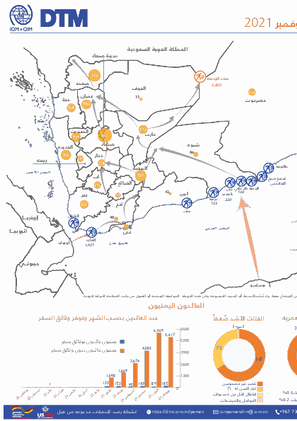
Contact
DTM Yemen, iomyemendtm@iom.int
Language
English
Location
Yemen
Period Covered
Nov 01 2021
Nov 30 2021
Activity
- Flow Monitoring Survey
- Flow Monitoring
تعمل مصفوفة تتبُع النزوح الخاصة بالمنظمة الدولية للهجرة في اليمن على مراقبة المواقع الرئيسية التي يصل عبرها المهاجرون على الحدود الساحلية الجنوبية، و مواقع العائدون اليمنيون والموجودة على الحدود الشمالية لليمن مع المملكة العربية السعودية. يُراقب الباحثون المتمركزون في نقاط رصد تدفق وصول المهاجرين والمواطنين اليمنيين من أجل التعرف على الأنماط المختلفة للهجرة وتقديم تقديرات كمية للمساعدة في تحديد عدد المهاجرين غير النظاميين في البلد. لا تمثل نقاط التدفق جميع التدفقات في اليمن ويجب فهمها على انها مؤشر للافراد الذين تم تسجيلهم في فترة التقرير. والجدير بالذكر أن القيود المفروضة على الوصول تَحُد من القدرة على جمع البيانات في بعض نقاط وصول المهاجرين.
في نوفمبر 2021 ، تقدر مصفوفة تتبع النزوح التابعة للمنظمة الدولية للهجرة في اليمن أن 3,622 مهاجرًا دخلوا اليمن ،مقارنة ب 4,300 مهاجرًا في اكتوبر 2021 . اتى النقص في عدد المهاجرين في نوفمبر مقارنة بشهر اكتوبر لاستقرار الاوضاع نسبيا في اثيوبيا وزيادة القيود الامنية من قوات خفر السواحل على الجانبين اليمني والجيبوتي. حيث مثل عدد المهاجرين من إثيوبيا 91 في المائة و ثمانية في المائة من الصوماليين و واحد في المائة سوريين. كانت غالبية المهاجرين من الذكور (71 ٪) ، مع (20%) من النساء ، و سته في المائة من الأولاد و ثلاثه في المائة من الفتيات اللواتي كنا ايضاً من ضمن المسافرين بالإضافة إلى ذلك ، تقدر مصفوفة تتبع النزوح أن 5،802 يمني عادوا من المملكة العربية السعودية خلال شهر نوفمبر 2021 ، مقارنة ب 6,158 في اكتوبر و 4,228 في سبتمبر 2021 . خلال الفترة بين 1 يناير و 30 نوفمبر 2021 ، وصل ما يقدر ب 24،002 مهاجرًا و 22,010 يمنيًا عائداً إلى اليمن.
خلال فترة التقرير في نوفمبر 2021، شوهد وصول 1,695 مهاجرا من الصومال وتم تسجيلهم في نقاط مراقبة التدفق في محافظتي شبوة وحضرموت حيث سجل في بئر علي 750 مهاجرا وا 725 في عرقة؛ و 220 تم تسجيلهم في نقطة مراقبة التدفق بعين بامعبد .بينما شهدت نقطة مراقبة التدفق في العارة بمحافظة لحج أكبر عدد من الوافدين ، حيث وصل 1,927 مهاجراً من جيبوتي.
المنهجيــة:
تهدف منهجية تتبع النزوح العالمية إلى التعرف على المناطق التي تحدث فيها الهجرة الداخلية والهجرة العابرة للحدود والهجرة الإقليمية. وتُنَفَذّ تقييمات التنقل للمناطق على المستوى الوطني. ومن ثم تقوم فرق مصفوفة التتبع بجمع المعلومات على المستوى المحلي للتعرف على نقاط العبور الرئيسية. يجمع الباحثون الميدانيون البيانات من مُدلين رئيسين بالمعلومات في نقاط رصد التدفق: ويمكن للمُدلين الرئيسيين ان يكونوا افرادً يعملون في النقل او موظفون في الجمارك او افرادً يعملون في قوارب او المهاجرون انفسهم. تُجمع البيانات باستخدام استمارة بسيطة و بالملاحظة المباشرة وهو ما يُسَهل عملية التحليل.
القيــــــود:
يجب تفسير البيانات المستخدمة في هذه العمليات كتقديراتً فقط، وانها تمثل فقط جزءاً من اجمالي التدفق الذي يمر عبر اليمن. ولذلك، ان التغطية الزمنية والمساحية غير مكتملة. وبالإضافة إلى ذلك، بالرغم من ان البيانات تُجمع بشكل يومي، إلا انها تُجمع فقط خلال ساعات الذروة. وإن نسبة التدفقات التي تحدث في الساعات التي لم تتم تغطيتها، لا تُمَثَل هنا. أما البيانات المتعلقة بالضُعف فهي ترتكز على الملاحظة المباشرة ويجب ان تفُهم بصفتها بيانات دلالية في المقام الأول.
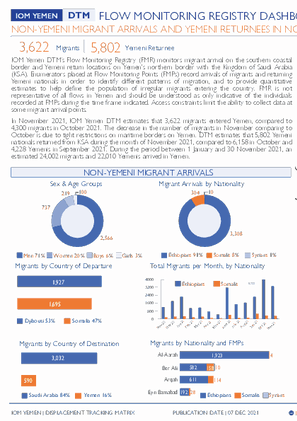
Contact
DTM Yemen, iomyemendtm@iom.int
Language
English
Location
Yemen
Period Covered
Nov 01 2021
Nov 30 2021
Activity
- Flow Monitoring Survey
- Flow Monitoring
IOM Yemen DTM’s Flow Monitoring Registry (FMR) monitors migrant arrival on the southern coastal border and Yemeni return locations on Yemen's northern border with the Kingdom of Saudi Arabia (KSA). Enumerators placed at Flow Monitoring Points (FMPs) record arrivals of migrants and returning Yemeni nationals in order to identify different patterns of migration, and to provide quantitative estimates to help define the population of irregular migrants entering the country. FMR is not representative of all flows in Yemen and should be understood as only indicative of the individuals recorded at FMPs during the time frame indicated. Access constraints limit the ability to collect data at some migrant arrival points.
In November 2021, IOM Yemen DTM estimates that 3,622 migrants entered Yemen, compared to 4,300 migrants in October 2021. The decrease in the number of migrants in November comparing to October is due to the stable security situation in Ethiopia, as well as the increase in military restrictions on maritime borders from the government side in Yemen and Djibouti. DTM estimates that 5,802 Yemeni returns from KSA during the month of November 2021, compared to 6,158 in October and 4,228 Yemenis in September 2021. During the period between 1 January and 30 November 2021, an estimated 24,002 migrants and 22,010 Yemenis arrived in Yemen.
The migrant caseload was 91 per cent Ethiopian, eight per cent Somali, and one per cent Syrian. The migrants are predominantly male (71%), with (20%) women, six per cent boys and three per cent girls also among the travelers.
Through November reporting period, 1,695 migrants arrived from Somalia and were recorded 750 at Ber Ali, 725 at Arqah, and 220 at Eyn Bamabad flow monitoring points in Shabwah and Hadramout governorates. Al Aarah flow monitoring point in Lahj governorate saw the highest number of migrant arrivals, with 1,927 migrants arriving from Djibouti.
METHODOLOGY:
DTM’s global flow monitoring methodology aims to identify areas prone to internal, cross-border and regional migration. Mobility area assessments are conducted at the national level. DTM teams then collect information at the local level to identify key transit points. Enumerators collect data from key informants at the flow monitoring points: key informants may be transport staff, custom officers, boat operators or migrants themselves. Data is collected through a basic form combined with direct observations –enabling breakdowns.
LIMITATIONS:
Data collected for these exercises should be understood as estimations only. They represent only part of the total flows passing through Yemen. The spatial and temporal coverage of this data collection activity is therefore incomplete. In addition, although data is collected daily, it is collected only during peak hours. The portion of the flows that occur during the uncovered hours is not represented. Data on vulnerability is based on direct observation and should be understood as mainly indicative.
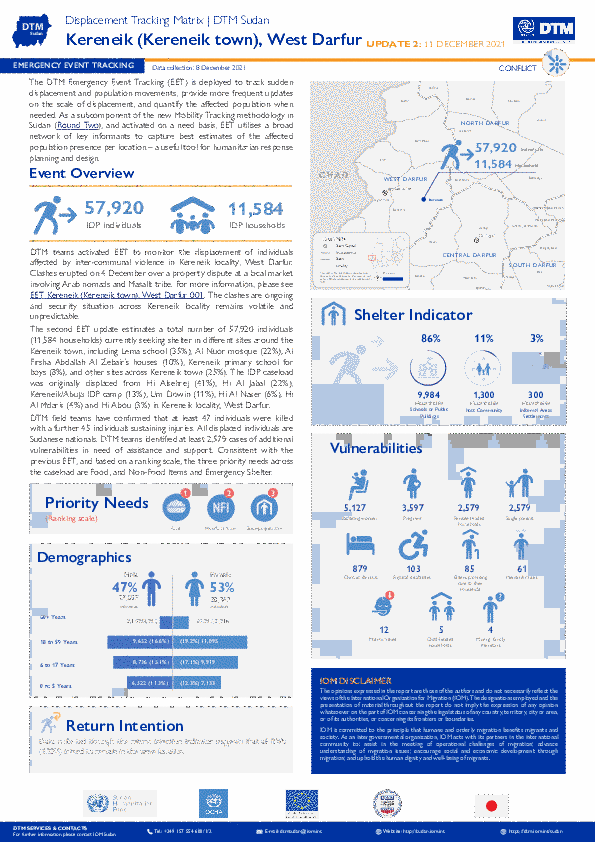
Contact
DTM Sudan; dtmsudan@iom.int
Language
English
Location
Sudan
Snapshot Date
Dec 08 2021
Activity
- Mobility Tracking
- Event Tracking
The DTM Emergency Event Tracking (EET) is deployed to track sudden displacement and population movements, provide more frequent updates on the scale of displacement, and quantify the affected population when needed. As a subcomponent of the new Mobility Tracking methodology in Sudan (Round One), and activated on a need basis, EET utilises a broad network of key informants to capture best estimates of the affected population presence per location – a useful tool for humanitarian response planning and design.

Contact
DTMMozambique@iom.int
Language
English
Location
Mozambique
Period Covered
Dec 01 2021
Dec 07 2021
Activity
- Event Tracking
- Mobility Tracking
During the reporting period (01 to 07 December 2021), a total of 42 movements were recorded - 7 intended return movements (1,218 individuals), 15 arrivals (317 individuals), 6 transits (258 individuals), and 14 departures (115 individuals). The largest transits were recorded in Mueda (206 individuals) and Nangade (52individuals). The largest arrivals were recorded in Nangade (164 individuals) and Mueda (43individuals). The intended return movements were observed in Montepuez (642 individuals) and Mueda (576 individuals). The largest departures were recorded in Balama (66 individuals) and Namuno (37 individuals). Of the total population (11%) were displaced for the first time. An estimated 89 per cent of reported IDPs had been displaced more than once prior to this latest movement.

Contact
DTM Mauritania, DTMMauritania@iom.int
Language
French
Location
Mauritania
Period Covered
Oct 06 2021
Nov 04 2021
Activity
- Other
- Survey
- Flow Monitoring
La pandémie de COVID-19 a eu un impact faible en Mauritanie. Au 9 décembre 2021, il y seuls 39 669 cas de COVID-19 étaient confirmés, dont 844 décès, tandis que 1 795 467 doses de vaccin avaient été administrées. Pour répondre à la pandémie et lutter contre sa propagation, le gouvernement de Mauritanie a néanmoins mis en œuvre un certain nombre de mesures strictes, dont des restrictions de mobilité et des campagnes d’information et sensibilisation.
Dans le cadre de ses activités de suivi des mouvements de transhumance (TTT), l’Organisation internationale pour les migrations (OIM) en Mauritanie en collaboration avec le Groupement National des Associations Pastorales (GNAP) met en place des activités de suivi des flux des troupeaux et personnes. Pour analyser le niveau de compréhension et de sensibilisation sur le COVID-19, des indicateurs additionnels ont été inclus dans le cadre des activités TTT pour analyser le niveau de compréhension et de sensibilisation des éleveurs transhumants sur le COVID-19. Suite à ces questions, les énumérateurs, formés par l’OIM et GNAP, utilisant les brochures du Ministère de la Santé, ont sensibilisé les individus interrogés sur la maladie et les moyens de limiter la contamination. Les données présentées sur cette page ont été recueillies lors d’enquêtes conduites dans les régions de Brakna, Gorgol, Hodh El-Chargui, Hodh El-Gharbi, Tagant et Trarza auprès des 514 transhumants entre le 6 octobre et le 4 novembre 2021
Contact
DTM Mozambique, DTMMozambique@iom.int
Location
Mozambique
Activity
- Mobility Tracking
- Baseline Assessment
Period Covered
Oct 18 2021 -Nov 05 2021
A baseline assessment is a sub-component of mobility tracking. It aims to collect data on IDP, migrant or returnee population presence in a defined administrative area of the country.
Population Groups
Survey Methodology
Unit of Analysis Or Observation
Type of Survey or Assessment
Keywords
Geographical Scope
Administrative boundaries with available data
The current dataset covers the following administrative boundaries
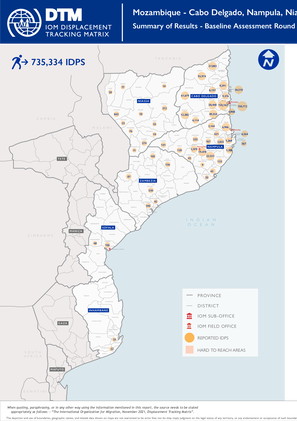
Contact
DTM Mozambique, DTMMozambique@iom.int
Language
English
Location
Mozambique
Period Covered
Oct 18 2021
Nov 05 2021
Activity
- Mobility Tracking
- Baseline Assessment
This fourteenth DTM Baseline Assessment Report aims to improve the understanding of internal displacement trends and displaced populations’ needs in Cabo Delgado, Inhambane, Niassa, Nampula, Zambezia and Sofala provinces. The DTM has focal points and enumerators in 277 localities of the Cabo Delgado province and collects data in close coordination with the Government. This 14th round of assessment also covered neighbouring provinces of Inhambane (2 localities, down from 6 reported in the previous round; the decrease was attributed to relocation) Nampula (53 localities), Niassa (14 localities), as well as the provinces of Zambezia (6 localities), and Sofala (2 localities). Security and access restraints in Mocimboa da Praia, Muidumbe and Palma districts have limited data collection resulting in no updated estimates recorded by DTM eld teams and focal points. For this round, 14 out of the 17 districts in Cabo Delgado were covered.

Contact
DTMcovid19@iom.int
Language
English
Location
Global
Period Covered
Dec 01 2020
Feb 14 2022
Activity
- Other
On 26 November 2021, WHO designated the variant B.1.1.529, named Omicron, a variant of concern on the advice of WHO’s Technical Advisory Group on Virus Evolution (TAG-VE). Since the Omicron variant was designated, new countries, territories or areas (C/T/As) have implemented more stringent mobility restrictions for individuals.
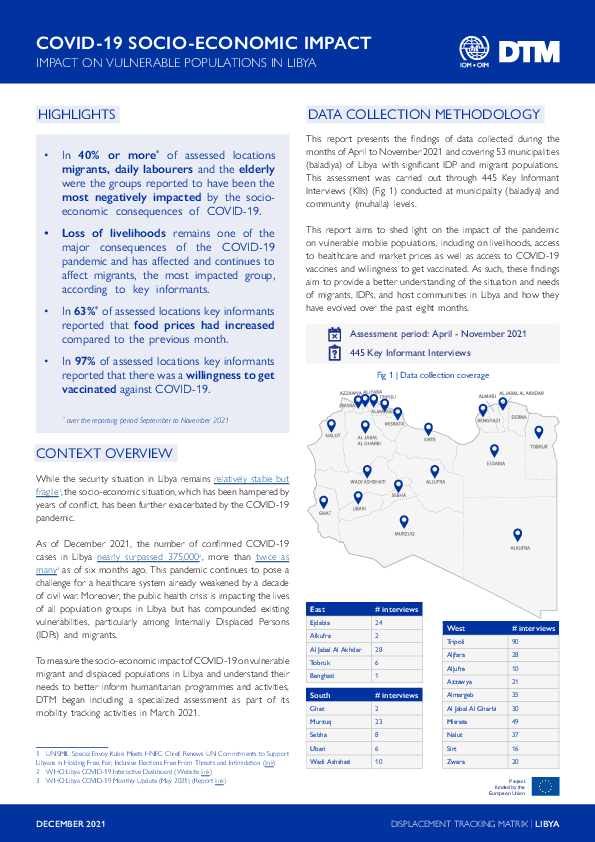
Contact
DTM Libya, DTMLibya@iom.int
Language
English
Location
Libya
Period Covered
Apr 01 2021
Nov 30 2021
Activity
- Other
This report presents the findings of data collected during the months of April to November 2021 and covering 53 municipalities (baladiya) of Libya with significant IDP and migrant populations. This assessment was carried out through 445 Key Informant Interviews (KIIs) conducted at municipality (baladiya) and community (muhalla) levels.
This report aims to shed light on the impact of the pandemic on vulnerable mobile populations, including on livelihoods, access to healthcare and market prices as well as access to COVID-19 vaccines and willingness to get vaccinated. As such, these findings aim to provide a better understanding of the situation and needs of migrants, IDPs, and host communities in Libya and how they have evolved over the past eight months.

Contact
DTM Nigeria, AllUsersInDTMNigeria@iom.int
Language
English
Location
Nigeria
Period Covered
Nov 29 2021
Dec 05 2021
Activity
- Event Tracking
- Mobility Tracking
Nigeria's North Central and North West Zones are afflicted with a multidimensional crisis that is rooted in long-standing tensions between ethnic and religious groups and involves attacks by criminal groups and banditry/hirabah (such as kidnapping and grand larceny along major highways). The crisis has accelerated during the past years because of the intensification of attacks and
has resulted in widespread displacement across the region.
In the evening of 3 December 2021, Sabon Birni town in Sabon Birni LGA in the state of Sokoto was attacked by armed bandits. Following this event, a rapid assessment was conducted by DTM (Displacement Tracking Matrix) field staff with the purpose of informing the humanitarian community and government partners, and enable targeted response. Flash reports utilise direct
observation and a broad network of key informants to gather representative data and collect information on the number, profile and immediate needs of affected populations.
